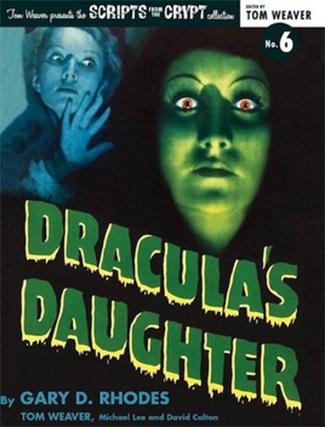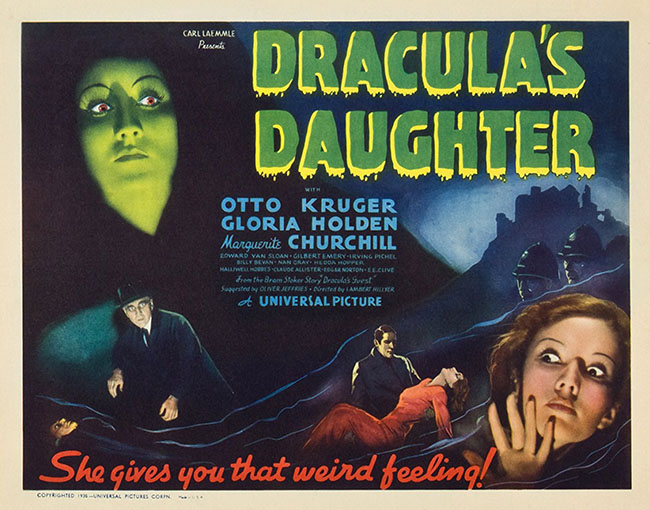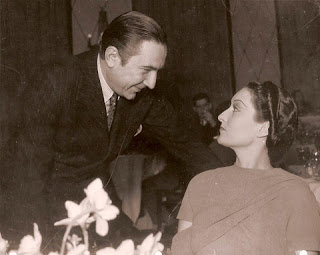Dracula’s Daughter
Gary D. Rhodes, Tom Weaver, Michael Lee and David Colton
Bear Manor Media—2017—349 Pages
reviewed by Michael Copner

Here is a 5-star rated book, an epic to one of the most underappreciated—yet most sensual—vampire classics of Hollywood’s 1930s output. Of course, we wish Bela was in the final cut. That was likely the intent of Carl Laemmle, Jr. when he commissioned the first treatment to be written by John Balderstone in 1933; that first draft, turned in during January of 1934, picks up in Castle Dracula in Transylvania, exactly where the 1931 Dracula concluded.
But by page 2 of the treatment, Mr. Balderstone had a change of heart about in which direction the plotline should unfold, and he explains his ideas explicitly. For starters, he notes: “The use of a female vampire instead of male gives us the chance to pay up SEX and CRUELTY legitimately. In Dracula that had to be almost eliminated because too horrible and unpleasant if added to the blood-sucking of women by a male monster.”
The cards are thus laid on the table that writer Balderstone plans to morph and shape shift the Dracula sequel into something other than what Universal Studios—and film-going audiences—might have been expecting. He carries his theme further on page 3 by declaring: “…why should Cecil DeMille have a monopoly of the great box office value of tortures and cruelty in pictures of ancient Rome? I want to establish in Part Two, the fact that Dracula’s Daughter enjoys torturing her male victims…and that these men under her spell rather like it. The censors will stand this provided it is done by suggestion and it gives us a big box-office value that we lacked before.”
* * *
Let me pause briefly in my book and script critique, to jump to a parallel line of reasoning. In 1977 I interviewed savvy media insider Katherine Orrison for an article in Cult Movies. One of her areas of special interest is in the cinematic art of Cecil B. DeMille. In the course of our discussion, Ms. Orrison observed: “DeMille always knew what audiences wanted to see. He made some fairly risqué product. Then the production codes cracked down on him and he got real creative—he made sexy films and called them biblical epics and he got away with murder.”
The reason for this quick intermission is several-fold: not only to state that Kathy Orrison is a lively Scorpio with a wild sense of humor. She had a far-reaching career as a designer in animated and live-action films. For Cult Movies, she contributed many articles and interviews—most popular response was for her interview with Yvonne De Carlo. She contributed brilliant, high-caliber content to CM, as did Gary D. Rhodes. One example was his tribute to silent film diva Alma Rubens. He’s since written books on directors Edgar Ulmer and Joseph E. Lewis and is currently researching details for a book on the 9 films Lugosi made for Monogram. Whether Gary and Kathy would have met, I’m not sure—but theirs would be a productive alliance as they possess many like attributes in the arts and entertainment field.
Dr. Rhodes is currently Postgraduate Director for Film Studies at the Queen’s University in Belfast, Northern Ireland. He would like to return home to America and spend some time in Hollywood “where the films are made”. But for now, his main vocation is in Ireland and there he must remain for awhile longer.
* * *
With those synchronicities of persons and events displayed, let’s return to our inspection of Dracula’s Daughter. Among the many exclusive extras in this magnificent book, is a reproduction of the pressbook for the film displaying ad slogans and tricks, all posters and 17 sizzling newspaper ads for theater owners to employ. The pressbook came from the personal collection of Ronald V. Borst.
One can tell a great deal about a film by the way the studio tries to sell their product—this somewhat contrary to the old adage to “never judge a book by its cover”. But the gothic, lush, art deco ads tell many an amazing tale about this ghastly, eerie horror. In most of the ads, the men shown are of little concern to us—only twice do we see co-star Edward Van Sloan. Most of the art is given over to Gloria Holden. A few times she appears nun-like—is that a cowl over her head or a drape of hair? In some close-ups, her eyes stare straight out of the newspaper, she’s glaring at you, the reader. Light catches her cheeks at odd angles, casting giant eyelash shadows that streak up to her brows and beyond. In 2 of the ads, she’s portrayed as a giantess in sheer evening gown; she towers above dwarfed crowds of mere mortals who clamor at her feet.
And those slogans! They finalize the message loud and clear. At least for those of us who bother to read the fine print:
No creature like her ever before!
She gives you that weird feeling!
Women obeyed her! Men feared her power!
Save the women of this city!
To look at her was dangerous!
And the beat goes on… To me these ads demonstrate that Universal hoped they had something desirable to take to market, and the top brass prayed they hadn’t stepped too far off the path. By 1936 they had a Frankenstein sequel and they hadn’t dared to film it without Karloff. What grudge or lapse of logic led them to greenlight a Dracula sequel with no Dracula? That would be misrepresenting the product. But, then again, those ads indicate Big U was trying to create a new character and genre—pertaining to a pseudo-lesbian dominatrix more seductive, evil and exotic than dear old Dad.

Brad Linaweaver and I were discussing this film and pronounced it good; but sans Lugosi it was just wrong. How could that happen? The studios heads ordered more fine tuning. Kurt Neumann did a treatment that was rejected. Parts of that treatment are represented in this book. R.C. Sherriff submitted a draft on November 16, 1935 and excerpts are included. This indicates that 2 years of preparation had thus far gone into something which would not be a totally satisfying movie; especially for Universal—contractually obliged to pay Lugosi his full fee for not being in the film.
Vacillation was the order of the day nearly up to the day the sequel began filming. Concerned suits felt the film might pale in quality and box office draw in comparison to 1936’s Invisible Ray. In a column of fun facts, compiled by Tom Weaver (editor of this Bear Manor series), it is suggested that the film was almost not made. Quoting Variety, January 7, 1936, the Hollywood Inside column notes: “Daughter currently looks like it will not be produced.”

One other facet of all thrashing around concerns The Raven—a film I have constantly called the greatest psychological thriller ever made. Reports are that The Raven also went through many treatment rewrites which ended up being a blueprint for one of the fastest-paced and streamlined (61 minutes) Lugosi film ever made.
In issue # 37 of Cult Movies, I referenced The Raven as the “Citizen Kane of horror thrillers.” We received lots of comment letters about that remark. The best one we printed in the next issue. A few lines from Bill Allen of Yonkers, NY. He’d enclosed 2 original art pieces combining the elements of Kane and Raven in novel ways any film fan would appreciate. Those too, ran in # 38.
To wrap up this endorsement of the new Dracula’s Daughter book, I’ll point out that a study of the book will help the reader understand the new directions and type of film Universal wanted to create. The exclusive extras, to be found nowhere else, are also of great value to film fans.
A couple of examples:
A photocopy of a handwritten letter actress Gloria Holden (Drac’s Daughter, herself!) written to film collector and historian David Del Valle
The TV script for Zacherley’s Shock Theater presentation of the film in 1958 for WCAU-TV in Philadelphia
The 16 page treatment for Carmilla from 1953 (when Universal thought about getting back into female vampire films)
Gary and company bring a treasure chest of facts, such as enthusiastic reports Louella Parsons was printing in 1953 and that Picturegoer magazine reported Marlena Dietrich was reading the script. Fans know this ambitious project was not produced.
Perhaps by the time one finishes a good study of this book, Gary’s encyclopedia on the Lugosi Monogram 9 will be in print.
| 






